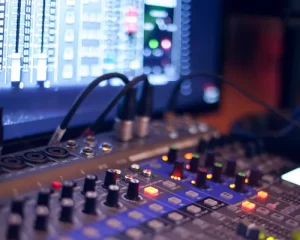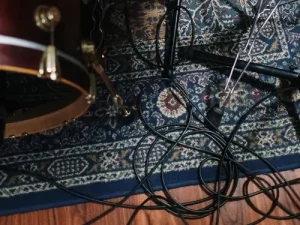Navigating the world of audio can feel like walking through a maze. Terms like "line level" and "mic level" may sound foreign to the novice ear. Yet, for music and audio enthusiasts, these are crucial concepts to understand. To simplify this intricate world, we're diving deep into the "line in vs. mic in" debate and decoding what it all means.
The Basics: What Are Audio Signals?
In any sound system, an audio signal is the voltage representation of sound. These signals vary in strength. The most common ones are mic-level signals, line-level signals, and speaker-level signals.
But what's the difference between them?
- Mic Level Signals: These are the weakest of the bunch, originating directly from microphones. They need an amplification boost to be processed by most equipment. Wondering why your microphone sounds so soft sometimes? Here's why your mic might be so quiet.
- Line Level Signals: Considered the middle child in the signal family, line-level signals come from devices like CD players, mixers, and synthesizers. They're stronger than mic-level signals but not as powerful as speaker-level signals.
- Speaker Level Signals: These are the strongest signals, generated after amplification. They drive speakers to produce sound audible to the human ear.
Line In vs. Mic In: What's the Difference?
 Both line-in and mic-ins are audio inputs, but that doesn't mean they're the same. The primary distinction between line in vs. mic in is their purpose and the type of signals they're designed to handle; one is for line signals, whereas the other is for mic signals.
Both line-in and mic-ins are audio inputs, but that doesn't mean they're the same. The primary distinction between line in vs. mic in is their purpose and the type of signals they're designed to handle; one is for line signals, whereas the other is for mic signals.
- Line In: As its name suggests, line-in is tailored for line-level signals. It's used for connecting external audio devices. If you've ever attached a CD player or an instrument to your system, chances are you've used the line input. Connectors for line-in usually include RCA, a ¼” phone jack, or a 3.5 mm phone jack. You can use them for a speaker-level signal or an instrument-level signal.
- Mic In: Specifically designed for mic level signals, mic in is the go-to for plugging in microphones. It uses a different connector, typically a female XLR connector. Mic inputs are vital because microphones produce weak signals, and these inputs offer the necessary amplification.
A key point to remember when debating line and mic levels is the danger of interchangeability. Imagine pouring a gallon of water into a tiny cup - disaster! Similarly, if you connect a line-level source to a mic input, expect loud and distorted sound. Why? They don't use the same input. The line-level signal is far stronger than the mic-level input can handle. It needs a line-level input.
It’s also important to mention that electronics like MP3 players and DVD players have a consumer line-level signal.
Transforming Signals: The Role of Preamps and Mixers
For a mic-level signal to be compatible with most devices, it must transform into a line-level signal. Enter: preamps and mixers.
A preamp amplifies the mic level signal to line level, allowing you to feed it into recording devices, mixers, or even your computer. You can use inline mic preamps to boost microphone levels. Mixers, while also capable of amplifying mic level to line level, provide added flexibility by allowing multiple audio signals to be blended.
If you're delving into the world of recording or streaming, investing in the right microphone is crucial. For budget-conscious folks, check out these excellent USB microphones under $50.
Can I Record Vocals Without Using a Preamp?
 Recording vocals is an art form, a dance of technology and talent. In the modern music production scene, the preamp plays a crucial role. It amplifies the delicate mic level signals to the sturdier line level, ensuring that vocals are captured clearly and with full-bodied resonance. But what if you don't have a preamp? Is it still possible to record vocals effectively?
Recording vocals is an art form, a dance of technology and talent. In the modern music production scene, the preamp plays a crucial role. It amplifies the delicate mic level signals to the sturdier line level, ensuring that vocals are captured clearly and with full-bodied resonance. But what if you don't have a preamp? Is it still possible to record vocals effectively?
The Role of a Preamp in Vocal Recording
Before delving into the possibilities of preamp-less recording, it's vital to understand the role of a preamp. A preamp, short for preamplifier, boosts the weak mic level signals to line level. This amplification ensures that the audio signal is strong enough for further processing, editing, or mixing. With a preamp, the nuances of a voice, from the softest whisper to the most potent note, are captured in all their glory.
The Direct Recording Route
So, you don't have a preamp but wish to record vocals? While not the most recommended method, it is technically possible. Some audio interfaces come with built-in preamps, allowing direct recording. When you plug a microphone into such interfaces, the mic-level signals are automatically boosted to line level.
However, while this method seems convenient, there are limitations:
- Quality Concerns: Built-in preamps in audio interfaces may not always offer the same level of quality as dedicated external preamps. The warmth, clarity, and dynamic range may be compromised.
- Lack of Control: Dedicated preamps often come with knobs and controls that allow for precise gain adjustment that you won't find on a typical audio interface. Direct recording will lack this flexibility.
- Risk of Noise: Without the fine-tuning capabilities of a dedicated preamp, you might encounter higher noise levels or interference in your recordings.
Making the Most of Your Setup
If you're keen on recording without a preamp, here are some tips:
- Choose a Quality Audio Interface: Invest in an audio interface known for its superior built-in preamp quality. While it might not match an external preamp's finesse, it can come close.
- Mind Your Environment: Without a preamp's added controls, environmental noise can become a more significant concern. Record in a quiet, well-treated space to minimize unwanted sounds.
- Post-Production Magic: Use software tools to enhance, clean, and refine your recordings. Equalization, noise reduction, and compression can make a substantial difference.
Common Mistakes When Dealing with Line and Mic Inputs
In the labyrinth of audio technology, it's easy to trip and fall, especially when dealing with a line or microphone input. They might seem straightforward, but they have their share of pitfalls, and navigating these can be the difference between crisp, clear sound and a distorted mess.
Let's explore the most common mistakes users make and provide solutions to keep your audio journey smooth.
Interchanging Line and Mic Inputs
The Mistake: One of the most common errors, especially among beginners, is plugging a line-level source (like a synthesizer) into a mic input or vice-versa. It's so important to know the difference between line-in and mic inputs.
The Result: You either get an overpoweringly loud, distorted sound or an almost inaudible whisper, neither of which is ideal.
The Solution: Always check the labeling on your equipment. Remember the basics: line inputs for line-level signals (e.g., instrument-level signals, mixers) and microphone inputs for mic-level signals (e.g., microphones).
Overlooking Gain Settings
The Mistake: Not adjusting the gain correctly for your input can lead to a plethora of audio issues.
The Result: Too much gain and you'll get clipping and distortion; too little and your sound will be drowned out.
The Solution: Always do a soundcheck before recording. Adjust the gain while monitoring the output to ensure you're in the "Goldilocks zone" - not too high, not too low.
Using the Wrong Cables
The Mistake: Using unbalanced cables when balanced ones are required or mismatching connectors.
The Result: Increased interference, noise, and potential signal loss.
The Solution: Understand the difference between balanced and unbalanced audio and cables. Use the correct type based on your equipment's requirements, and always ensure connectors match.
Ignoring Cable Length
The Mistake: Using excessively long cables when they aren't necessary.
The Result: Longer cables can lead to signal degradation and increased susceptibility to interference.
The Solution: Use the shortest cable that meets your needs. If you need long cables, ensure they are of high quality and are designed for minimal signal loss.
Neglecting Device Compatibility
The Mistake: Assuming that all devices and their respective inputs/outputs are universally compatible.
The Result: Devices might not communicate efficiently, leading to poor sound quality or even damage in some cases.
The Solution: Always read the device manual and ensure that the devices you're connecting are compatible in terms of signal strength and connector type.
Skipping Impedance Matching
The Mistake: Not considering the impedance of devices when connecting them.
The Result: Mismatched impedance can affect sound quality and volume, making it either too weak or too strong.
The Solution: Familiarize yourself with the concept of impedance. Match sources and destinations (like microphones and mixers) with similar impedance levels for the best results. Remember, mixers can combine multiple signals in one output.
The Impact of Cable Quality and Length

As with many things in life, when it comes to audio cables, not all are created equal. The choice of cable can greatly influence the purity, strength, and overall quality of your audio signals. This might seem like a minor detail to some, but for audio enthusiasts, professionals, and anyone desiring clarity in sound, understanding the impact of cable quality and length is paramount.
Cable Quality: More than Just a Price Tag
The quality of a cable is determined by several factors:
- Material: Cables are primarily made of copper, but high-quality ones might feature oxygen-free copper or silver, ensuring minimal resistance and excellent conductivity.
- Shielding: Good cables have proper shielding to prevent external interferences like radio frequencies (RFI) or electromagnetic interferences (EMI) from corrupting the audio signal.
- Connectors: The quality of connectors (often gold-plated) ensures a better connection and reduces the risk of corrosion, which can degrade signal quality over time.
Impact: Using low-quality cables can introduce noise, reduce the signal's strength, and even alter the audio's fidelity. On the other hand, high-quality cables maintain signal purity and resist external interferences.
Cable Length: The Shorter, The Better?
The length of a cable is directly tied to signal strength and quality:
- Resistance: The longer the cable, the more resistance it offers. This means that as you increase the length, there's a higher chance for the signal to degrade, especially if the cable isn't of high quality.
- Capacitance: Long cables can introduce higher capacitance, which might affect the high-frequency response of audio signals, leading to sound alterations.
- Interference: The more extended a cable, the higher its susceptibility to external interference, especially if it lacks proper shielding.
Impact: While it's not always detrimental to use long cables, it's essential to know that they come with inherent challenges. Whenever possible, use the shortest cable that serves your purpose to ensure minimal signal loss and degradation.
The Argument for Investing in Good Cables
For those on the fence about investing in high-quality cables, here are some points to consider:
- Longevity: High-quality cables are built to last. They resist wear and tear, ensuring you won't have to replace them frequently.
- Performance: The difference in sound clarity between a generic cable and a high-end one can be night and day, especially in professional setups.
- Cost-Efficiency: While good cables might be pricier upfront, their longevity and performance can save money in the long run by avoiding frequent replacements and potential equipment damage.
In the vast universe of audio equipment, cables might seem like mere accessories. However, understanding their impact is crucial for anyone serious about audio quality. Investing in high-quality cables and being mindful of their length can make a world of difference, turning a good audio setup into a great one. As the adage goes, "A chain is only as strong as its weakest link." Ensure your audio chain remains robust by choosing the right cables.
Why It Matters: Perfect Sound Needs Precision
 Imagine savoring your favorite song through the best headphones. The highs, the lows, the impeccable clarity - all possible due to the careful handling of audio signals at various stages.
Imagine savoring your favorite song through the best headphones. The highs, the lows, the impeccable clarity - all possible due to the careful handling of audio signals at various stages.
Understanding the distinction and nuances between line levels and mic levels is pivotal in creating and enjoying high-quality audio. It ensures that signals are at their optimal levels for processing, recording, and playback without distortion or noise.
Wrapping Up
In the realm of audio, precision is paramount. Whether you're an audiophile, a music producer, or just a casual listener, having a foundational grasp of mic and line levels and inputs can significantly enhance your auditory experiences. Remember, it's not just about the sounds you hear but also the science behind how you hear them. So, the next time you're plugging in a device, whether that's a mic, mixer, or an electric guitar or adjusting your audio setup, you'll do so with a newfound appreciation and understanding.
